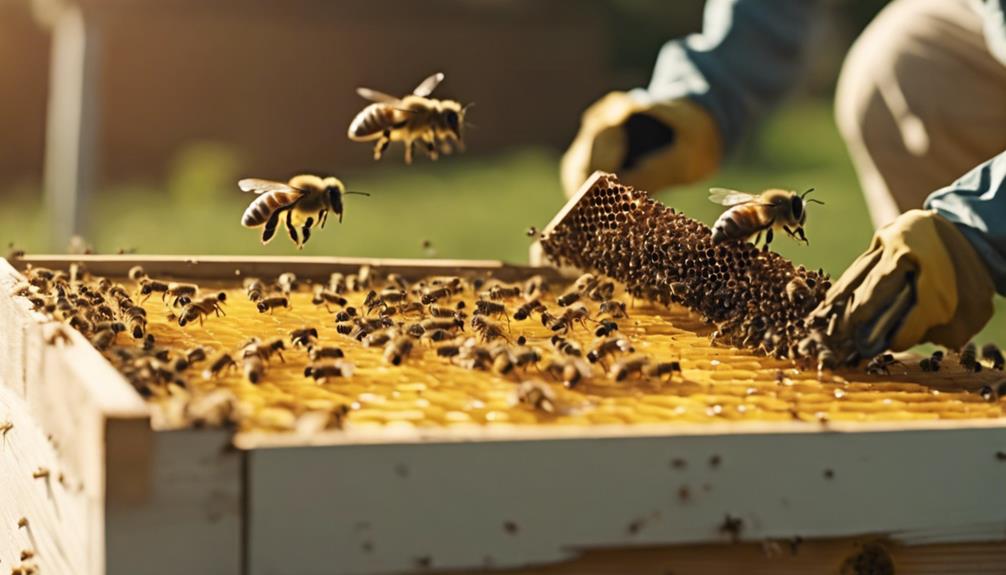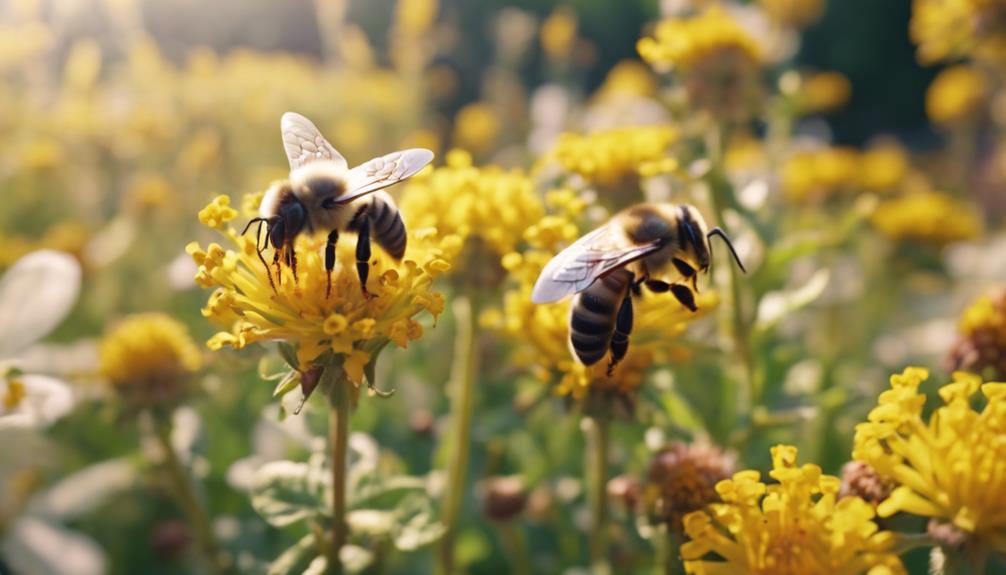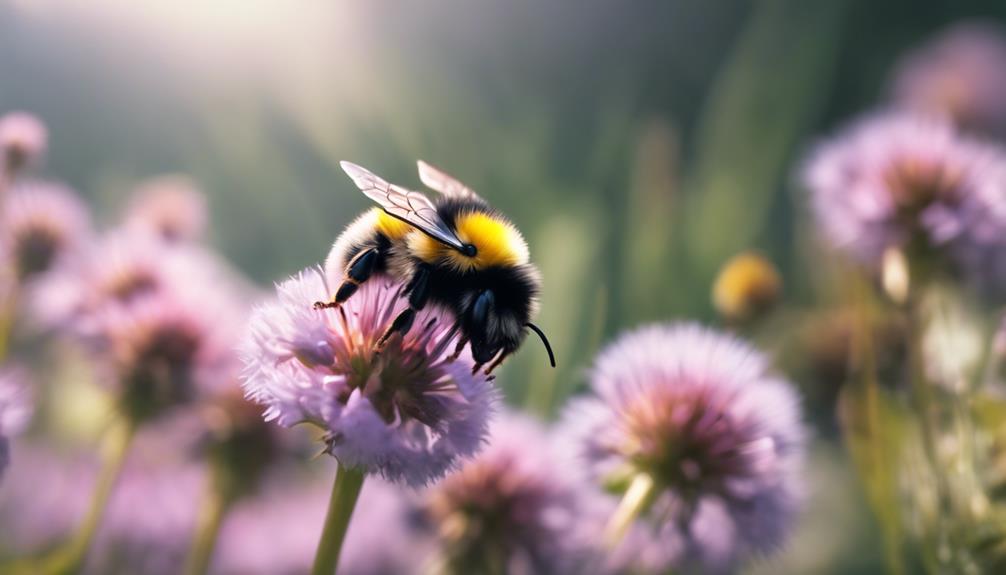In a honeybee colony, we worker bees are the backbone of the hive, taking on a multitude of essential roles. From maintaining hive cleanliness to caring for the queen and foraging for important resources like pollen and nectar, we guarantee the colony’s well-being, growth, and sustainability. Our tasks range from constructing honeycomb cells with beeswax to defending the hive against potential threats, all to secure the colony’s success. Our efforts support not only the queen’s reproductive role but also the overall productivity of the hive. Keep exploring, and you’ll discover just how intricate and crucial our contributions are to the colony’s functioning.
Main Points
- Maintain hive cleanliness and temperature regulation.
- Gather resources like pollen and nectar for the colony.
- Care for the queen, drones, and larvae.
- Produce wax and construct honeycomb cells.
- Defend the hive against predators and intruders.
Worker Bee Tasks and Responsibilities
We, as worker bees in a honeybee colony, undertake various tasks and responsibilities essential for the hive‘s functioning. Starting as housekeeping bees, we meticulously clean cells and prepare them for new eggs, ensuring the hive remains a clean and healthy environment.
Shifting to nurse bees, we delicately feed brood cells and attend to the queen’s needs, nurturing the future generation of bees. As wax masons, we diligently produce wax for building honeycomb, showcasing our architectural skills within the hive.
Later in life, we bravely take on the role of guards, protecting the hive from any potential threats. Finally, as foragers, we venture outside to collect precious resources like pollen, nectar, propolis, and water, ensuring the colony’s sustenance and survival.
Our anatomy perfectly equips us for these diverse tasks, allowing us to serve the hive with utmost dedication and efficiency.
Interaction With Queen and Drones
Interacting closely with the queen and drones plays a pivotal role in the reproductive success and longevity of a honeybee colony. Worker bees support the queen’s well-being by feeding and caring for her, which is essential for her reproductive success.
When it’s time for mating flights, workers play a key role in facilitating interactions between the queen and drones, allowing for fertilization to occur and ensuring the colony’s continuation through generations. By regulating these interactions, workers support the queen in her vital role as the central reproductive figure of the colony.
Their efforts not only contribute to the queen’s health and egg-laying capabilities but also play a significant part in the colony’s overall growth and sustainability.
Role in Hive Maintenance

Playing an essential role in hive maintenance, worker bees diligently perform a variety of tasks critical for the colony’s well-being. Here’s how they keep our hive in top shape:
- Cleaning Crew: Workers maintain hive cleanliness by removing debris, dead bees, and waste materials to guarantee a hygienic environment.
- Temperature Control: They regulate hive temperature and humidity by fanning their wings or clustering together to maintain ideal conditions for brood development.
- Architects of the Hive: Worker bees construct and repair honeycomb cells using beeswax, providing storage space for food, eggs, and developing larvae.
- Nutrition Providers: These bees feed the queen, drones, and larvae with royal jelly, pollen, and nectar to support their growth and development within the colony.
- Security Team: Workers play a critical role in defending the hive against predators and intruders, utilizing their stingers and coordinating to protect the colony.
Lifecycle and Development Stages
During their lifecycle in a honeybee colony, worker bees progress through stages of egg, larval, pupal, and adult development. As larvae, we’re nurtured by nurse bees who feed us a special concoction of honey, pollen, and glandular secretions, paving the way for our transformation into adult worker bees. This care is essential for our growth and development within the colony.
After the pupal stage, we emerge as fully-fledged adults ready to take on our important roles. Becoming an adult worker bee marks the beginning of our contributions to the hive, supporting the queen, caring for the brood, and ensuring the hive functions smoothly. Our journey from larvae to adult worker bee is significant for the colony’s survival and productivity.
Importance of Worker Bees

Worker bees are essential contributors to the hive’s functionality and overall success. Here are five reasons highlighting the importance of worker bees in a hive:
- Multitasking Marvels: Worker bees juggle various tasks like feeding larvae, foraging for food, and maintaining the hive’s structure with precision.
- Pollination Powerhouses: Their role in pollination is vital for the ecosystem and boosts agricultural productivity, guaranteeing a bounty of fruits and vegetables.
- Colony Caretakers: Worker bees ensure the colony’s survival by caring for the queen, regulating temperature, producing wax, and controlling humidity levels.
- Egg-laying Experts: In the absence of a queen, worker bees can step up and lay eggs to sustain the colony’s population, showcasing their adaptability.
- Key to Hive Management: Understanding the diverse roles and responsibilities of worker bees is crucial for effective hive management and productivity.

Hello! My name is Noel Calvin. I graduated from UCLA and now work as a writer at Launch Ninjas. I write blog posts that inspire and guide our readers in their entrepreneurial pursuits. I live in Pleasantville, NJ, with a peaceful yet lively atmosphere that inspires me.
Writing stories is more than just a job for me. It allows me to share my observations and satisfy my curiosity about the world. I combine my analytical skills with creative enthusiasm to delve into technology trends and startup stories. But my life isn’t limited to screens and keyboards. I value loyalty, passion, and a touch of old-fashioned charm, which I infuse into every narrative I create.
I love spending time in my garage, jamming with my band when I’m not writing. Playing the guitar and singing bring me immense joy. I also enjoy capturing ordinary and extraordinary moments through my camera lens and exploring new culinary adventures that excite my taste buds. I’m always seeking new experiences.
My family is very important to me. Joyful Sunday brunches filled with laughter and intense board game nights keep me grounded, reminding me of life’s simple pleasures.
In my world, every moment is an opportunity for discovery. Every discovery is a story worth sharing, whether a heartfelt moment at home or the pulse of technological innovations. Join me as I navigate through life, one blog post, one guitar strum, and one heartwarming family dinner at a time.


